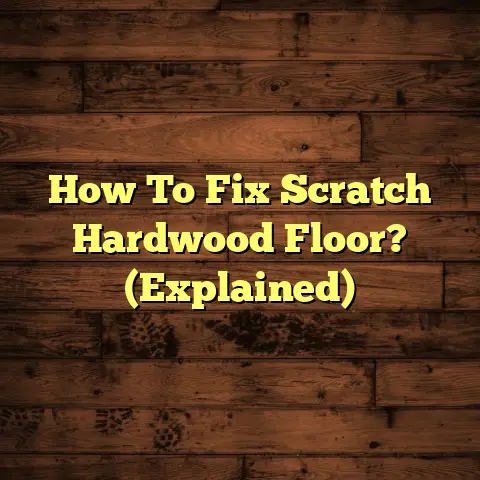Vinyl Plank: What’s It Made Of? (3 Hidden Layers!)
Ever wondered how much your flooring choices impact your energy bill?
It’s a lot more than you think!
As a flooring contractor with years of experience, I’ve seen firsthand how the right flooring can transform a space and save you money.
And today, I want to talk about one of my favorite options: vinyl plank flooring.
It’s stylish, durable, and surprisingly energy-efficient when you choose wisely.
But what exactly is vinyl plank flooring, and what makes it so great?
The secret lies in its layers – three hidden layers that work together to provide comfort, stability, and long-lasting performance.
Let’s dive in and uncover the mysteries of vinyl plank flooring!
Overview of Vinyl Plank Flooring
So, what is vinyl plank flooring, anyway?
Simply put, it’s a type of flooring made from synthetic materials designed to mimic the look of real wood or stone.
Unlike traditional sheet vinyl, vinyl plank comes in individual planks or tiles that click together for easy installation.
And let me tell you, it’s become incredibly popular in recent years.
Why?
Well, for starters, it’s water-resistant, making it perfect for kitchens, bathrooms, and basements.
It’s also incredibly durable, standing up to heavy foot traffic, kids, and pets.
Plus, it comes in a huge variety of styles and colors, so you can find the perfect look for your home.
Now, you might be wondering, “Is vinyl plank the same as luxury vinyl tile (LVT) or luxury vinyl plank (LVP)?”
That’s a great question!
The terms are often used interchangeably, but generally, LVT and LVP are considered higher-end versions of vinyl flooring.
They tend to have thicker wear layers, more realistic designs, and enhanced features like текстурированная surfaces.
But regardless of what you call it, vinyl plank flooring offers a ton of benefits:
-
Water Resistance: Perfect for moisture-prone areas.
-
Easy Installation: Many options feature click-lock systems for DIY projects.
-
Durability: Resists scratches, stains, and wear and tear.
-
Design Variety: Mimics the look of wood, stone, and tile.
-
Cost-Effectiveness: Often more affordable than hardwood or tile.
But here’s the real kicker: the three hidden layers that make up vinyl plank flooring are the key to its performance and longevity.
These layers are:
- The Wear Layer
- The Core Layer
- The Backing Layer
Each layer plays a crucial role in protecting your floor and keeping it looking its best.
And, as I mentioned earlier, some of these layers can even contribute to energy savings!
Let’s take a closer look at each one.
The Top Layer – The Wear Layer
Alright, let’s start with the star of the show: the wear layer.
This is the top layer of the vinyl plank, and it’s responsible for protecting the underlying layers from scratches, stains, and UV damage.
Think of it as the floor’s bodyguard, shielding it from the daily wear and tear of life.
The wear layer is typically made of a clear, protective coating, often polyurethane or a similar material.
It’s designed to be incredibly tough and resistant to abrasion, so it can withstand heavy foot traffic, pet claws, and dropped objects.
Now, here’s where things get interesting: the thickness of the wear layer directly impacts the durability and maintenance of your vinyl plank flooring.
The thicker the wear layer, the more resistant it is to scratches and wear.
As a general rule, I recommend looking for a wear layer of at least 12 mil (0.3 mm) for residential use.
For commercial spaces with heavy traffic, you’ll want to go even thicker, around 20 mil (0.5 mm) or more.
Here’s a quick breakdown:
But how does the wear layer contribute to energy savings?
Well, while it’s not the primary source of insulation, it does play a role in maintaining a consistent temperature in your home.
By protecting the underlying layers from damage, the wear layer helps to prevent heat loss and maintain the floor’s structural integrity.
This can lead to lower heating costs over time, especially when combined with other energy-efficient features.
Also, some wear layers are treated with UV inhibitors, which help to block out harmful UV rays from the sun.
This not only protects the flooring from fading but also helps to reduce heat gain in your home, keeping it cooler in the summer.
The Core Layer – Stability and Comfort
Alright, now let’s move on to the core layer, which is the heart and soul of vinyl plank flooring.
This layer is responsible for providing structural integrity, stability, and comfort underfoot.
It’s like the backbone of the flooring, giving it the strength and support it needs to withstand daily use.
The core layer can be made of several different materials, each with its own unique properties:
PVC (Polyvinyl Chloride): This is the most common type of core layer material.
It’s durable, water-resistant, and relatively inexpensive.WPC (Wood Plastic Composite): WPC cores are made from a blend of wood flour and plastic.
They’re more rigid than PVC cores and offer better sound absorption.SPC (Stone Plastic Composite): SPC cores are made from a blend of limestone and plastic.
They’re the most rigid and durable type of core layer, making them ideal for high-traffic areas.
Which type of core layer is best?
Well, it depends on your specific needs and budget.
PVC cores are a good option for most residential applications, while WPC and SPC cores are better suited for commercial spaces or areas with high moisture levels.
The core layer also contributes to comfort underfoot and sound absorption.
WPC cores, in particular, tend to be softer and more comfortable to walk on than PVC or SPC cores.
They also do a better job of absorbing sound, which can be a major plus in apartments or homes with multiple floors.
But what about energy savings?
Well, the core layer can also play a role in thermal insulation.
WPC cores, for example, have better insulating properties than PVC or SPC cores.
This means they can help to reduce heat loss in the winter and keep your home cooler in the summer.
Additionally, the sound-dampening properties of the core layer can also contribute to energy savings.
By reducing noise pollution, you can create a more comfortable and relaxing environment, which can lead to lower stress levels and better sleep.
And when you’re well-rested, you’re less likely to crank up the heat or air conditioning to compensate for discomfort.
The Backing Layer – Foundation and Support
Last but not least, we have the backing layer.
This is the bottom layer of the vinyl plank, and it serves as a foundation for the entire flooring system.
It’s like the floor’s safety net, providing stability, cushioning, and insulation.
The backing layer can be made from a variety of materials, including:
Felt: Felt backings are soft and provide good cushioning.
They’re often used in residential applications.-
Foam: Foam backings are similar to felt backings but offer even more cushioning and sound absorption.
Rubber: Rubber backings are the most durable and resilient type of backing layer.
They’re often used in commercial spaces or areas with heavy traffic.
The backing layer plays a crucial role in the installation process.
It provides a stable surface for the vinyl plank to adhere to, ensuring a long-lasting and trouble-free installation.
It also helps to hide minor imperfections in the subfloor, which can save you time and money on subfloor preparation.
But the backing layer also enhances comfort, reduces noise, and provides insulation.
Felt and foam backings, in particular, offer excellent cushioning, making the floor more comfortable to walk on.
They also help to absorb sound, reducing noise transmission between floors.
And, of course, the backing layer can also contribute to energy efficiency.
By providing an extra layer of insulation, it can help to maintain indoor temperatures and reduce energy costs.
In fact, according to the U.S.
Department of Energy, flooring
can account for up to 10% of
a home’s energy loss.
By choosing a vinyl plank flooring with a high-quality backing layer, you can help to minimize this energy loss and save money on your utility bills.
Additional Features of Vinyl Plank Flooring
Now that we’ve covered the three hidden layers of vinyl plank flooring, let’s briefly touch upon some other features that can enhance its performance:
-
Waterproofing: Some vinyl plank flooring is completely waterproof, making it ideal for bathrooms, kitchens, and basements.
-
Anti-Microbial Properties: Some vinyl plank flooring is treated with anti-microbial agents, which help to prevent the growth of mold and mildew.
Ease of Cleaning: Vinyl plank flooring is incredibly easy to clean.
Simply sweep or mop with a mild detergent and water.
These features not only improve the user experience but also contribute to long-term energy efficiency and sustainability.
For example, waterproof flooring can prevent moisture damage, which can lead to costly repairs and energy loss.
Anti-microbial properties can improve indoor air quality, which can reduce respiratory problems and improve overall health.
And easy cleaning can reduce the need for harsh chemicals, which can be harmful to the environment.
The Future of Vinyl Plank Flooring
So, what does the future hold for vinyl plank flooring?
Well, I believe we’ll continue to see innovations in materials and design, which will further enhance its energy efficiency and sustainability.
For example, manufacturers are experimenting with new types of core layer materials that offer even better insulation and sound absorption.
They’re also developing more sustainable manufacturing processes that reduce waste and minimize environmental impact.
And, of course, we’ll continue to see new and exciting designs that mimic the look of natural materials like wood and stone.
Ultimately, the key to making informed flooring choices is to understand the materials and layers that comprise vinyl plank flooring.
By knowing what to look for, you can choose a flooring that not only looks great but also supports energy efficiency and sustainability.
So, the next time you’re shopping for flooring, remember the three hidden layers of vinyl plank flooring: the wear layer, the core layer, and the backing layer.
And don’t be afraid to ask questions and do your research.
Your floors are a big investment, so it’s important to choose wisely.
Happy flooring!





